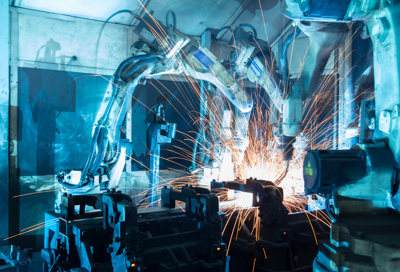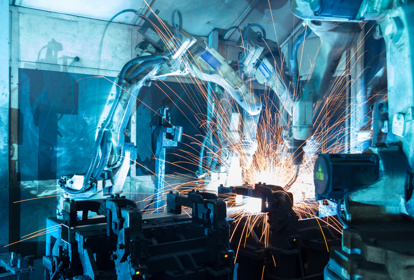
Connecting predictive maintenance software to automated stock management technology could enable factory machines to order their own replacement parts.
Could a welding machine order its own replacement for a worn-out part?
The Digital Spare Parts Supply Chain (DSPSC) project aimed to answer that question and demonstrate how smart technologies could be used to transform factory maintenance in the future
Innovation Case Study - DSPSCWith £227,000 of funding from the Made Smarter Innovation Challenge, DPSPC brought together supply chain management company NBT Group Ltd, along with industrial software business Senseye Ltd and academic experts from the University of Northumbria to explore how artificial intelligence could be applied to inventory control and supply chain management in the manufacturing industries.
“A factory has a welding robot, for example. At some point, a bearing will wear out and a new one ordered for it to be replaced. At the moment, factories rely on people manually checking machinery and ordering parts,” explains project lead Toby Bridges, Executive Chair at NBT Group. “Our vision is a smart system that can predict when a part needs to be replaced, and then order it – all without the need for human intervention.” DSPSC investigated the feasibility of connecting two smart technologies to achieve this goal: Senseye Ltd’s predictive maintenance software, which provides industrial maintenance teams with an indication of which parts will need replacing and when; and NBT Group’s stock management software.
“For a factory machine to be able to order its replacement part, data must be able to flow accurately through both systems, so we worked with Senseye and Northumbria University’s Global Operations and Supply Chain Competitiveness (GLOPSCO) research interest group to widen our thinking on how to integrate NBT Group’s supply chain technologies into other systems and technologies across a manufacturing plant,” says Bridges.
“We also modelled the benefits such a system would bring across various sized factories, which suggested the value of those savings on a large manufacturing site could be in the region of £40m.” These potential savings come from multiple efficiencies. Removing administrative and manual tasks, and Connecting predictive maintenance software to automated stock management technology could enable factory machines to order their own replacement parts Digital Spare Parts Supply Chain: An Integrated Solution of Spare Parts Inventory Management and Predictive Maintenance connecting these systems digitally, means unnecessary stock holdings could be reduced, freeing up space for production, driving down costs and carbon emissions. It could also create efficiencies among a wider manufacturing supply chain, providing for improved client work scheduling. It also impacts the workforce, says Bridges. “A connected factory doesn’t need someone to check on machinery twice a day, so it begins to allow businesses to utilise people in higher value roles. With levelling up, there is a lot of discussion about better quality jobs, and this type of technology can open the doors.
However, what this project also highlighted was a concern among many workers that jobs are being ‘replaced’ with machines. So, a key learning was that organisations needs to ensure teams are culturally on board to prevent a stumbling block to any technology roll out.” Connecting predictive maintenance and digital supply chain technology could also offer benefits to other sectors.
“In this instance, we looked at factory machinery but there is scope for any organisation that has machines and parts that require repair – an ambulance perhaps – or industries that have a digital inventory, such as a finance system,” says Bridges. “The opportunities are huge, and the outcomes and knowledge acquired from this project will pave the way for further research and development, with the ultimate aim of exploiting new technology to help increase productivity, create more highly skilled roles and become more economically, socially and environmentally sustainable.





